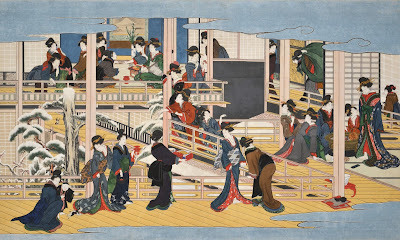Artist Research: Kitagawa Utamaro
Since my project will be based on the Japanese Mythology and I am still unsure about the style and media I am going to use I thought that it was important to research about Japanese Artists and the traditional Japanese artworks. For this reason, I researched about the artists Kitagawa Utamaro and his woodblock prints. I will possibly also use him for my student talk next week.
Kitagawa Utamaro
Little is known about Kitagawa Utamaro - there are many theories about his life but there is not much documents that support these. Kitagawa Nebsuyoshi, later Kitagawa Utamaro, was born in the year of 1753 in Japan, possibly in Edo (now known as the city of Tokyo) and died on 1806. It is believed that during his whole career he created around 2000 artworks. He was a Japanese printmaker and painter, considered one of the best artists of the ukiyo-e movement.
It is said during his childhood he was called Ichitaro but during his career he used a variety of other names such as Yusuke, Yuki, Nobuyoshi and Toyoaki. It was under this last name that he started to paint woodblock prints of woman alhough these were not original of his. Only in the year of 1781- 82 he started to use the name Utamaro.
Around the year of 1791 Utamaro focused mostly in painting single portraits of women instead of women in groups (subject commonly painted by the ukiyo-u artists) and these models were normally take from the street and lower classes.
In 1804 Utamaro published a print of a historic scene of the ruler Toyotomi Hideyoshi with his wife and five other concubines entitled Taiko Rakuto Go Sai Yukon (The Taiko “Hideyoshi” and His Five Wives Picnicking at Rakuto). This print was against the censorship laws of that time ( it was forbidden to portrait military heroes in prints and/or popular works) and got him into serious problems. He was accused of insulting the Hideyoshi's pride and dignity and for this reason he was imprisoned for 3 days and had to wear handcuffs for other 50 days. This experience was extremely humiliating for the artist and he fell into a sever depression.
Three Beauties of the Present Day (Tōji San Bijin, 当時三美人)
This full colour print (commonly called nishiki-e) is the representation of, as the tittle mentions, three beautiful women: Takashima Hisa (on the left) and Naniwa Kita (on the right) and Tomimoto Toyohina, a geisha (on the top). Both of these two first women have their family's crest in their clothes, that is to say that they were from the urban population, which reflects the innovative subject matter of Utamaro.
The triangular composition present in tis print is inspired by "The Three Vinegar Wine Tasters" (16th century). After Utamaro, many other artists from the same movement as him adopted this type of composition. His style in which he used flat areas of colour and strong lines, influenced many Western Artists.
Utamaro's influence on Western Artists
Utamaro K. (1795) Takashima Ohisa Using Two Mirrors to Observe Her Coiffure [Woodblock print]
Many Western artists such as Henri Toulouse-Lautrec, Edgar Degas, James Abbott McNeill Whistler, Mary Cassat have been inspired from Japanese traditional art and techniques. These artists, for example, were deeply influenced by the ukiyo-e movement: Mary Cassatt, similarly to the Japanese prints, only used flat colours and strong lines, which was the only element that would give dimensionality to the print. This features are clear in her painting "The Coiffure" (1890-91) which is very similar to Utamaro's painting "Takashima Ohisa Using Two Mirrors to Observe Her Coiffure" (1795)
Likewise, it is said that Edgar Degas' painting "Women Combing Her Hair" is also inspired by one of Utamaro's prints "Yamauba Combing Her Hair and Kintoki" (1801).
Althought I am not thinking about being directly inspired by Utamaro's style this research made me understand that the colour palette I had in mind was probably not the right choice for this subject and that I should opt for a pastel collour palette. This will create a connection with the traditional Japanese prints and give a beautiful consistency to the series. In the next few weeks I will try to research further in order to understand which style I am going to adopt for the collection.
Reference:
Artsper Magazine (n.d.) The Influence of Japanese Art on Western Artists [online] Available from: https://blog.artsper.com/en/a-closer-look/influence-of-japanese-art-on-western-artists/ [Accessed 17.04.2021]
The Art Story (n.d.) Ukiyo-e Japanese Prints Artworks [online] Available from: https://www.theartstory.org/movement/ukiyo-e-japanese-woodblock-prints/artworks/ [17.04.2021]
Britannica Academic (2009) Utamaro [online] Available from: https://academic-eb-com.proxy.library.dmu.ac.uk/levels/collegiate/article/Utamaro/74550 [Accessed 17.04.2021]
Wanczura D. (n.d.)Utamaro Kitagawa - 1750-1806 [online] Available from: https://www.artelino.com/articles/utamaro.asp [Accessed 17.04.2021]
Waldman F. and Frazer D. (n.d.) UTAMARO BIOGRAPHY [online] The Art of Japan, Available from: https://www.theartofjapan.com/artist-bio/?at=Utamaro [Accessed 17.04.2021]
Sandrey D. (n.d.) Kitagawa Utamaro: Discover Japanese Beauty Through his Masterpieces [online] Available from: https://japanobjects.com/features/utamaro-prints [Accessed 17.04.2021]






Comments
Post a Comment